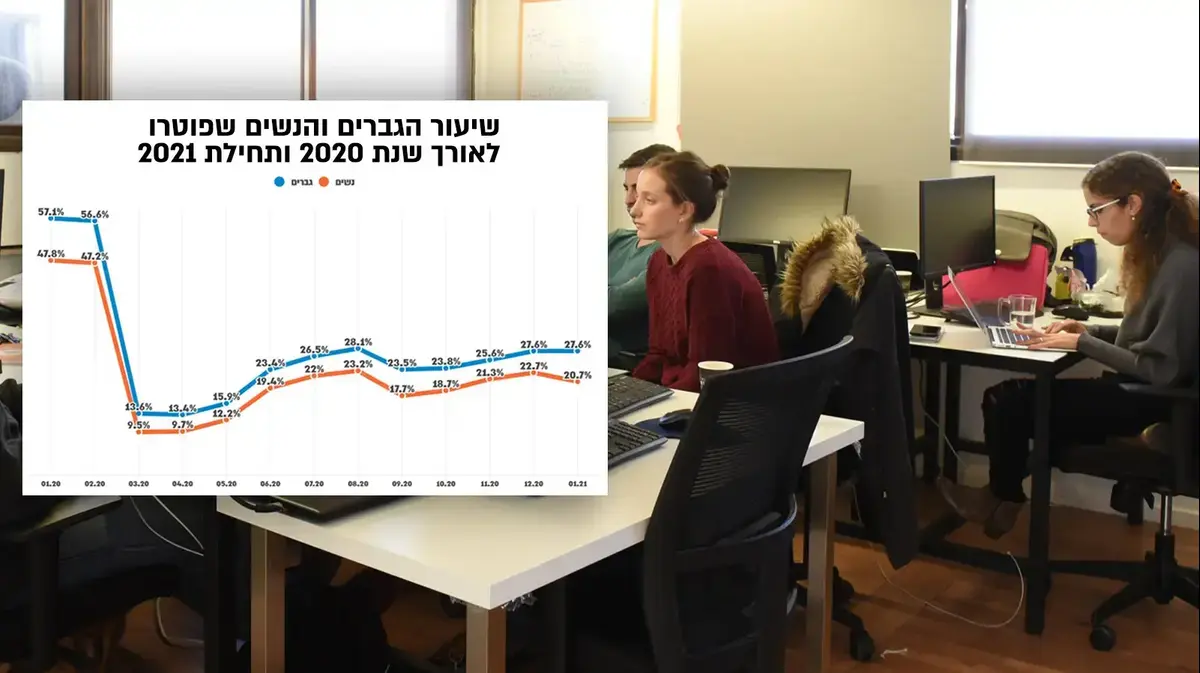news
News in Israel
Events in Israel
First to pay the price: This is how the corona has affected women in the labor market
A study published by the Employment Service ahead of Women's Day shows that in the crisis year, more women were registered as requiring work than men, but they returned to work at a higher rate.
Due to the dependence of their work on closures, they went out more and were fired less. And when they close the school, the mothers are forced to stay home with the children.
Tags
Employment Services
Corona virus
women
International Women's Day
Sonia Gorodisky
Sunday, 07 March 2021, 13:00
Share on Facebook
Share on WhatsApp
Share on general
Share on general
Share on Twitter
Share on Email
0 comments
An expression of gender inequality that characterized the employment market even before the crisis.
The Employment Service in Jerusalem (Photo: Flash 90, Yonatan Zindel)
More women were enrolled in the employment service during the Corona crisis, but their rates of return to work are higher compared to men, according to a study published today (Sunday) on International Women's Day.
According to the study, the number of registrations as job seekers during the past year is an expression of the gender inequality that characterized the Israeli employment market even before the Corona crisis.
With the entry into the closures, the proportion of women enrolled in the employment service increased, while with the exit from the closures, the gap between them narrowed.
Over the past year, the proportion of women job seekers has ranged from 58.5 to 52.5%, depending on restrictions.
In April 2020, the number of enrollees in the employment service reached a peak of 621,081, compared to 500,246 among men.
More on Walla!
Economists predicted a revolution in the employment market within a decade.
Then came the corona
To the full article
Read more on the subject
More than 150,000 job seekers since the beginning of the closure, the main victims: teaching staff
Israel's strange case: Why did the economy survive the corona, but the labor market hurt?
80% of the unemployed in the third closure - lost their jobs more than once since the outbreak of the crisis
The system that helps teachers help students
According to Dr. Gal Zohar, director of the Employment Service's Research and Policy Unit, the corona crisis reflected the gender division of the labor market. The proportion of women engaged in soft occupations that were most vulnerable during the closure period - sales and services, teaching, education and training - was significantly higher than men. Zohar argued that the volatility of women leaving and returning to work at the time of entry and exit from quarantine has a long-term impact on the career advancement possibilities of their careers.
The children stay at home - and the mothers with them
The study also shows that women pay the price of closing the education system, even if they do not work in it.
Kindergartens and schools have been closed for extended periods in the past year, and according to Zohar, in the absence of a framework the mothers were usually forced to look after the children.
"This mainly reflects an economic decision, when the spouse who earns higher wages is the one who will continue to work, while the spouse who earns lower wages and the exchange rate between his wages and the higher benefit paid to him will exercise his entitlement to unemployment benefits," he explained. Dr. Zohar.
The proportion of ultra-Orthodox women entering the labor market is higher than men (Photo: Flash 90, Abir Sultan)
Segmented, in Jewish society - the ultra-Orthodox and the non-ultra-Orthodox - women were harmed more, while in Arab society men were harmed more.
The study shows that one of the reasons why women in the ultra-Orthodox sector registered more as jobseekers is their higher rate in the employment market compared to ultra-Orthodox men.
Arab society The opposite is true, since the proportion of women in the labor market is significantly lower than the proportion of men, and consequently also in the proportion of jobseekers.
According to the Employment Service, the gender distribution of the laid off raises a mirror image of the gender distribution of those going on unpaid leave (Khalat). While women have a higher rate of women leaving for Khalat, men have a higher rate of dismissals throughout the crisis months. .
This information also shows women's dependence on labor market volatility during the crisis year.
Men are less dependent on the opening and closing of the economy, whether they go out to the hospital and their chances of getting into a prolonged illness are higher, or whether they are fired.
Share on Facebook
Share on WhatsApp
Share on general
Share on general
Share on Twitter
Share on Email
0 comments

